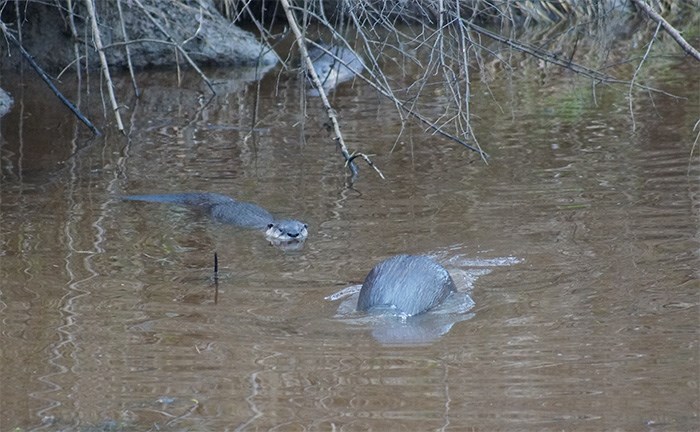 Three river otters in a land-locked lagoon near Richmond’s City Centre
Three river otters in a land-locked lagoon near Richmond’s City Centre
A trio of “roving bachelor” river otters has requisitioned a relatively new, inner-city lagoon — a “rare” and “amazing” event, according to a local biologist, who was among the first people to discover them.
While walking home on a late December day, from City Centre to his home near Garden City elementary, biologist and nature blogger Dr. Hugh Griffith passed through Garden City Community Park and heard a loud splash while passing over the lagoon’s bridge.
There, three otters appeared, apparently happy as clams, eating some small fish.
“I thought, what kind of duck is that? It kept going down under the water,” said Griffith.
“The fella I was with, together, we realized at the same time, they’re otters! Then we saw there were three. They came out on the bank, frolicked around and came back in the water again,” said Griffith.
The zoologist believes the otters have established a den underneath some bushes. They are feeding on the likes of bullheads, stickleback and catfish, which have made their way into the lagoon via storm drains connected to the Fraser River. Castaway goldfish are another treat.
How did the otters get there?
“It’s a real puzzle,” said Griffith. “We were surprised . . . To get here they would have to travel over land, or through ditches or through culverts, or a combination of those three, to get here. The question then is, what would inspire them to do that? Because they’re not supposed to be setting out on a Hawaiian journey without a clue of what they’re doing.”
The 17-acre park is located between Garden City Road and No. 4 roads, at Granville Avenue. As the crow flies it is about 250 metres away from the Agricultural Land Reserve. Likewise, it’s also 500 metres away from Richmond Centre.
“Maybe they came overland, loping down busy streets through Christmas shoppers, standing on each other’s shoulders to push the walk signal at corners, wrapped in a trench coat and wearing a fedora,” Griffith hypothesized on his local nature blog RockPaperLizard.Blogspot.ca.
City of Richmond spokesperson Ted Townsend said it is unusual to see the otters so far inland and in a heavily-populated area. Like Griffith, city officials are stumped as to exactly how the three amigos got there.
“But wildlife have proven to be very adaptive when it comes to moving into urban areas,” said Townsend, via email, adding the otters are welcome to stay and are not a threat to public safety.
“As is our practise with most other urban wildlife, we choose to co-exist with them. Plus, they’re cute,” said Townsend.
Griffith expects the otters to move on once the fish are eaten.
“It's all fun and games until the fish run out,” said Griffith.
“A more natural setting is for them to roam for some distances, over the course of a year. They don’t tend to stay in one spot for long, because they tend to exhaust their food supply,” said Griffith.
However, “my worry is they won’t know where they’re going; they may end up as road kill or some other unfortunate fate,” said Griffith.
Otters eat mostly fish but may also eat small mammals, such as mice, rats and even baby beavers, who nest along the river.
Griffith said the fact that otters appear to be thriving in the park, built in 2001, is a testament to its natural setting.
“The park has changed a lot. But for something that was dugout of a bunch of backyards in Richmond it really has been fruitful in terms of wildlife,” he said.
Griffith said the lagoon is an important habitat for all the park’s animals. Townsend said water levels are kept lower during the winter, via an adjustable dam, as a drainage buffer.


